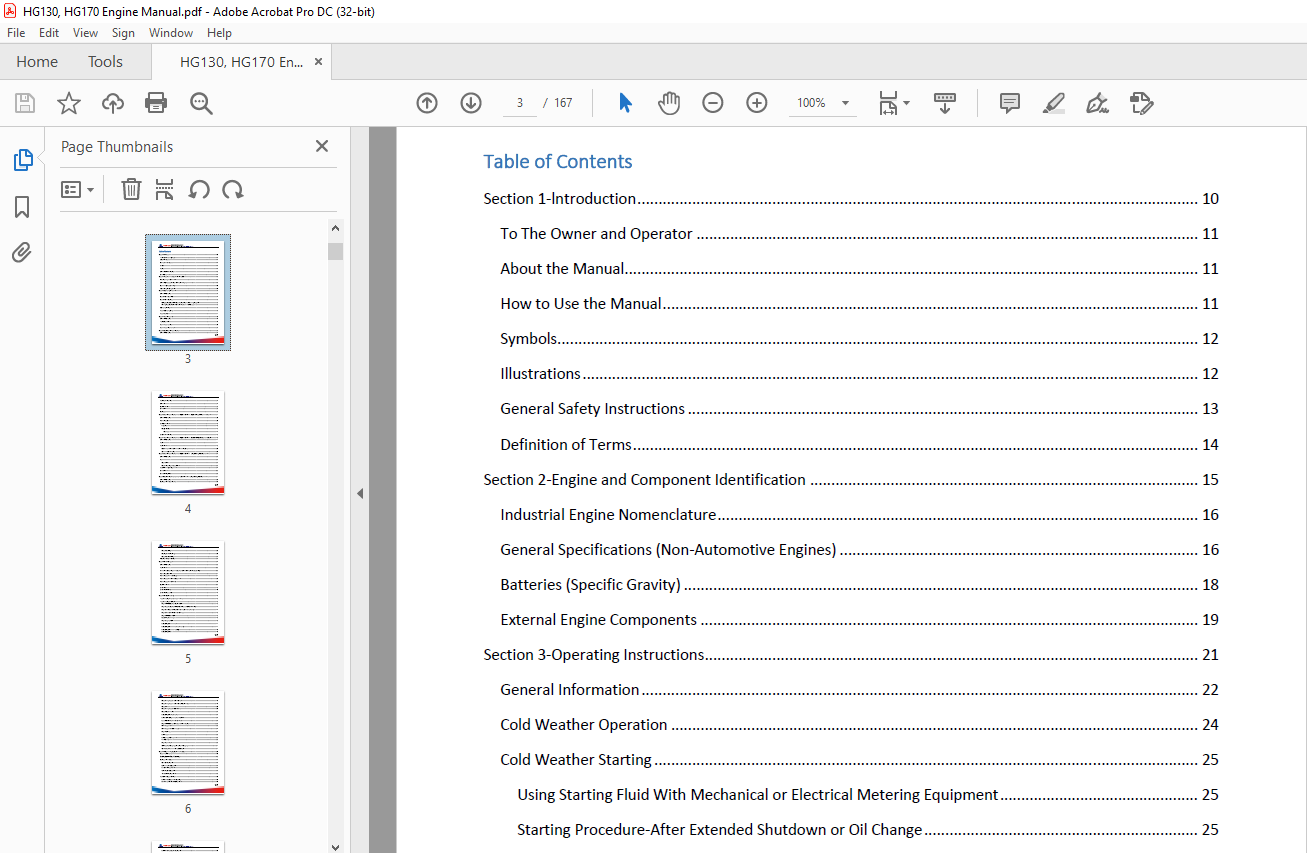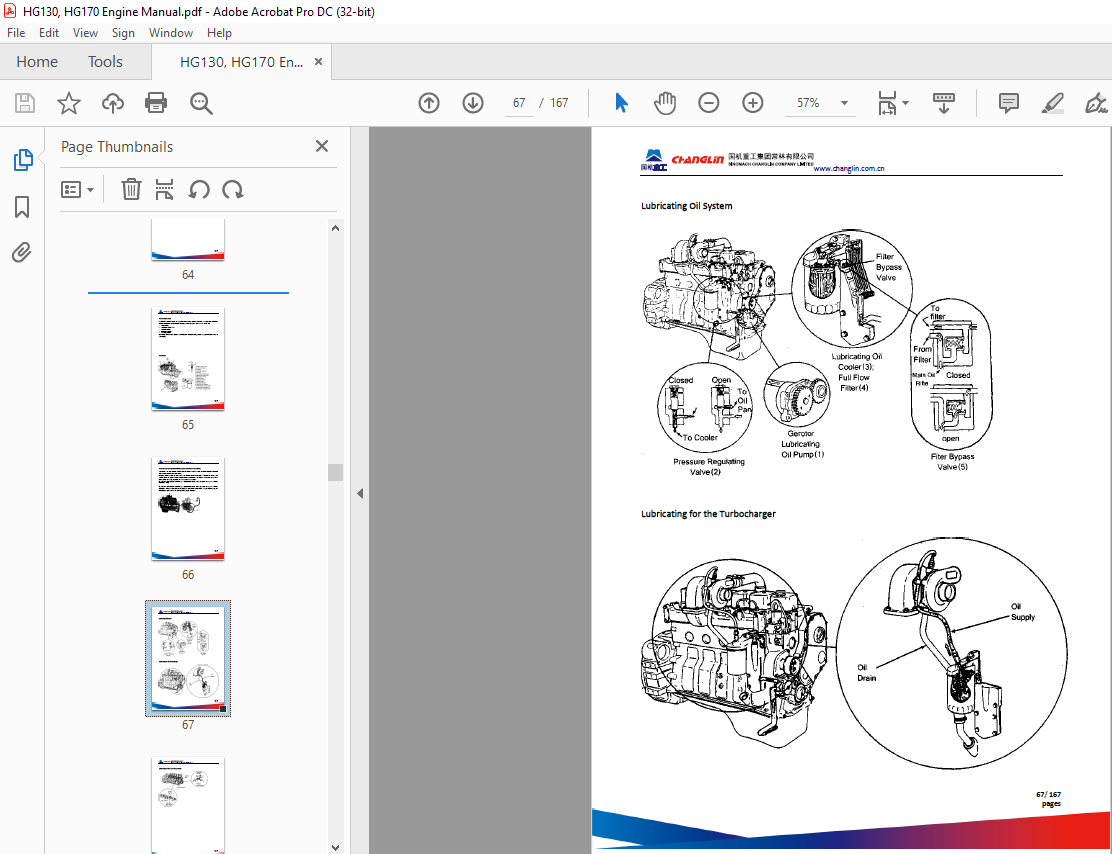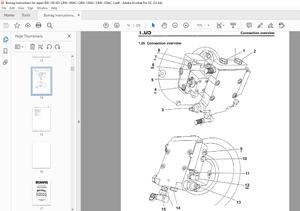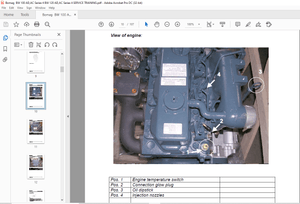$30.95
Hyundai (HG130, HL170) B Series Engines Operation and Maintenance Manual - PDF
Hyundai (HG130, HL170) B Series Engines Operation and Maintenance Manual – PDF DOWNLOAD
FILE DETAILS:
Hyundai (HG130, HL170) B Series Engines Operation and Maintenance Manual – PDF DOWNLOAD
Language : English
Pages :167
Downloadable : Yes
File Type : PDF
IMAGES PREVIEW OF THE MANUAL:



TABLE OF CONTENTS:
Hyundai (HG130 HL170) B Series Engines Operation and Maintenance Manual – PDF DOWNLOAD
Table of Contents
Section 1‐lntroduction 10
To The Owner and Operator 11
About the Manual 11
How to Use the Manual 11
Symbols 12
Illustrations 12
General Safety Instructions 13
Definition of Terms 14
Section 2‐Engine and Component Identification 15
Industrial Engine Nomenclature 16
General Specifications (Non‐Automotive Engines) 16
Batteries (Specific Gravity) 18
External Engine Components 19
Section 3‐Operating Instructions 21
General Information 22
Cold Weather Operation 24
Cold Weather Starting 25
Using Starting Fluid With Mechanical or Electrical Metering Equipment 25
Starting Procedure‐After Extended Shutdown or Oil Change 25
Operating the Engine 26
Engine Operating Range 26
Engine Shut‐down 27
Section 4‐Maintenance Guidelines 28
General Information 29
Tool Requirements 29
Maintenance Schedule 30
Maintenance Record From 32
Section 5‐Daily Maintenance Procedures 33
General Information 34
Fuel‐Water Separator 34
Oil Level 34
Coolant Level 35
Drive Belt 36
Cooling Fan 36
Section 6‐Maintenance Procedures at 10,000 Kilometers [6,000 Miles], 250 Hours or 3 Months 37
General Information 38
Lubricating Oil and Filter 38
Air Intake System 43
Inspection 43
Charge Air Cooler 43
Cleaning 44
Air Cleaner Restriction 45
Section 7‐Maintenance Procedures at 19,000 Kilometers [12,000 Miles], 500 Hours or 6 Months 46
General Information 47
Fuel Filter 47
Fuel System 48
High Pressure Lines (Rotary and‐ In‐line Pumps) 50
Antifreeze Concentration 50
Section 6‐Maintenance Procedures at 38,000 Kilometers [24,000 Mi], 1000 Hours or 1 Year 51
General Information 52
Valves 52
Adjustment 52
Four Cylinder Engine Adjustment 53
Six‐Cylinder Engine Adjustment 54
Drive Belt Tension 55
Drive Belt Inspection 56
Section8‐Maintenance Procedures at 77,000 Kilometers [48,000 Mi], 2000 Hours or 2 Year 57
General Information 58
Cooling System Maintenance 58
Coolant draining 58
Cooling System Flushing 60
Coolant System Filling 61
Vibration Damper (Rubber) 62
Section 9‐System Diagrams 64
General Information 65
Fuel System 65
Hydraulic Cold Start Injection Advance (Rotary Automotive Pumps Only) 66
Lubricating Oil System 67
Lubricating for the Turbocharger 67
Lubricating for the Power Components 68
Lubricating for the Overhead 69
Coolant System 69
Air System 70
Air System‐Intake Air 70
Air System‐Exhaust Air 71
Section 10‐Troubleshooting 72
Troubleshooting Procedures and Techniques 73
Troubleshooting Symptoms 73
Engine Will Nqt Crank or Cranks Slowly 73
Engine Hard to Start or Will Not Start (Exhaust Smoke Present) 74
Engine Cranks But Will Not Start (No Smoke From Exhaust) 74
Engine Starts But will Not Keep Running 75
Engine Will Not Shut Off 75
Rough Idle, Warm Engine 76
Engine Surges at Idle 76
Lubricating Oil Pressure Low 77
Lubricating Oil Pressure Low (Continued) 77
Lubricating Oil Pressure Too High 78
Lubricating Oil Loss 78
Coolant Temperature Above Normal 79
Coolant Temperature Above Normal (Continued) 79
Coolant Loss 80
Coolant Temperature Below Normal 80
Coolant Contaminated 81
Lubricating Oil Contaminated 81
Fuel or Oil Leaking from Exhaust Manifold 82
Exhaust Smoke Excessive Under Load 82
Engine Will Not Reach Rated Speed When Loaded 83
Power Output Low 83
Power Output Low (Continued) 84
Engine Misfiring 84
Fuel Knock 85
Fuel Consumption Excessive 85
Vibration Excessive 86
Engine Noises Excessive 86
Alternator Not Charging or Insufficient Charging 87
White Smoke Excessive During Cold Start 87
Section 11‐Adjustment, Replacement and Repair 89
Repair Tools Required 90
Cooling System Repair Summary 90
Cooling System Repair 91
Drive Belt‐Replacement 91
Belt Tensioner‐Replacement 91
Fan Pulley‐Replacement 92
Water Pump‐Replacement 92
Thermostat‐Replacement 95
Fuel System Repair Summary 98
Fuel System Components‐Cleaning 98
Low Pressure Fuel Line‐Replacement 99
Fuel Filter Head Adapter‐Replacement 99
Lift Pump‐Replacement Preparatory Steps: 100
High Pressure Fuel Lines‐Replacement Preparatory Steps: 101
Fuel Drain Manifold‐Replacement 102
Injection Pump Supply Line‐Replacement 103
Injectors‐Replacement Preparatory Steps: 104
Fuel Shut Off Solenoid‐Replacement 107
KDB Temperature Switch Replacement 109
Fuel Pump‐Replacement 109
Fuel System Repair‐In‐Line Pump 119
Fuel system Components‐£leaning 119
Low Pressure Fuel Line‐Replacement 120
Fuel Filter Head Adapter‐Replacement 120
High Pressure Fuel Lines‐Replacement 122
Fuel Drain Manifold‐Replacement 123
Injectors-Replacement 124
Injector Bore Brush 124
Fuel Shutoff Solenoid‐Replacement Preparatory Steps: 126
injection Pump‐Replacement 126
Injection Pump‐Idle Speed Adjustment 132
RQVK Governor 132
Air System Repair Summary 133
Air Crossover Tube‐Replacement 133
Jacket‐Water Aftercooler and Gasket‐ Replacement 136
Charge Air Cooler‐Leak Check 138
Turbocharger‐Replacement 140
Exhaust Manifold and Gaskets ‐Replacement 145
Lubricating System Repair 146
Oil Pressure Regulator, Valve and Spring Replacement 146
Oil Cooler Element and Gasket‐Replacement Preparatory Steps: 147Electrical System Repair 150
Starting Motor‐Replacement 150
Alternator‐Replacement 151
Section 12‐Specifications and Torque Values 153
General Specifications (Automotive Engines) 156
Fuel Recommendations / Specifications 158
Lubricating Oil Recommendations / Specifications 159
Oil Performance Recommendations 159
Oil Viscosity Recommendations 160
New Engine Break‐In Oils 160
Arctic Operation 161
Coolant Recommendations / Specifications 162
Filter Selection 163
Oil Filters 163
Fuel Filters 163
Engine Component Torque Value 164
Sealants 165
Capscrew Markings and Torque Values 166
Capscrew Markings and Torque Values‐Metric 167
Capscrew Markings and Torque Values ‐ US Customary 167



